#Owsley Stanley
Text

Owsley Stanley & Jerry Garcia, 1969.
Photo : Rosie McGee.
87 notes
·
View notes
Text

Owsley Stanley (The Bear) - United States Air Force Radio Operator, Radio and Television Announcer, Sound Engineer for the Band Greatful Dead (He inspired the band's dancing bear logo. along with his friend Bob Thomas , designed the logo for the sound system, consisting of a skull at the top of which there were two areas, one red and the other blue, crossed by lightning). Activist during the Freedom Campaign of the summer of 1964 and against the Vietnam War.
He sold weed seeds of the Heavenly Blue variety.
He produced 'Owsley' LSD, the most powerful of the time.
By the time acid drinking was made illegal in October 1966, Owsley had already amassed a huge fortune and become a living legend. He continued supplying LSD to big concerts. Such is the case of the 1967 Monterey Pop Festival, where he came with a new variety baptized for the occasion as Monterey Purple and which was consumed, among others, by Pete Townshend, Jimi Hendrix and Brian Jones. It is even said that The Bear sent his acid to the Beatles - on the other side of the pond.
His connection with the world of music has been captured by several songs inspired by him or in which mention is made of him. Such is the case of "The other one" or "Alice D. Millionaire", by the Grateful Dead; "Kid Charlemagne" by Steely Dan; "Mexico", by Jefferson Airplane; "Who needs the peace corps?", by Frank Zappa & The Mothers of Invention; or the version that Jimi Hendrix recorded of "Day Tripper" during his BBC sessions and in which he pronounces "Oh Owsley, can you hear me now?"
Stanley died on Saturday, March 12, 2011 in a car accident in Australia at the age of 76, elevated to the altars of the counterculture.
Source

↟↟ Oh Owsley, can you hear me? ↟↟ - Playing tracks by Grateful Dead, Jefferson Airplane, The Jimi Hendrix Experience, Frank Zappa & The Mothers of Invention and Steely Dan.
#owsley stanley#the bear#lsd manefacturer#lsd#60s psychedelia#psychedelic rock#flowers generation#age of aquarius#counterculture#counterculture icon#activist#music#musica#rock#rock music#acid rock
32 notes
·
View notes
Photo
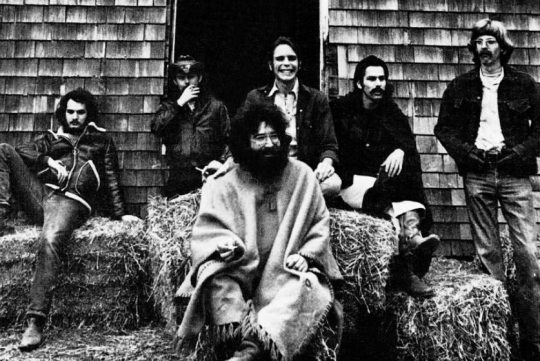

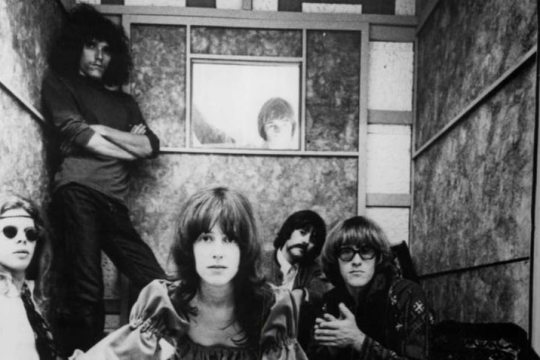

Grateful Dead
Jerry Garcia & Owsley Stanley
Jefferson Airplane
Merry Pranksters
28 notes
·
View notes
Photo
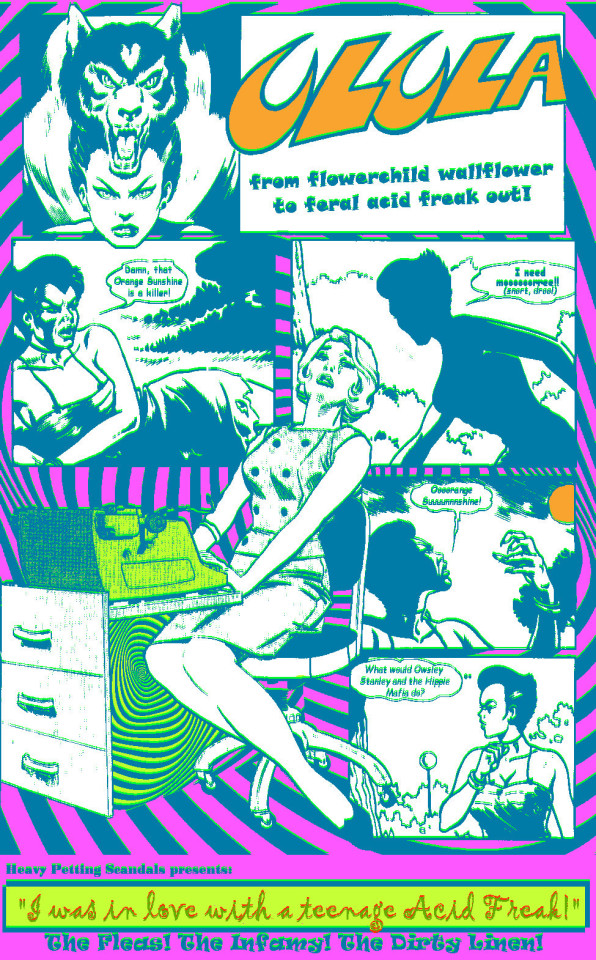

Text:
Ulula/ from flowerchild wallflower/ to feral acid freakout!/ “Damn, that orange sunshine is a killer!/ I need mooooore! (snort, drool)/ Oooorange Suuuunshine!/ What would Owsley Stanley and the Hippie Mafia do?/ Heavy Petting Scandals presents:/ “I was in love with a teenage Acid Freak!”/ The Fleas! The Infamy! The Dirty Linen!
#orange sunshine#owsley stanley#hippie mafia#petting scandals#I was in love with a teenage Acid Freak#the fleas#the infamy#the dirty linen#acid frog friday
37 notes
·
View notes
Text

Sound architect and Lysergic Acid pioneer Augustus “Bear’” Owsley Stanley died this week in his adopted home of Australia. The sixties counterculture fixture (see: Ken Kesey, the Grateful Dead, the Acid Tests, Tom Wolfe, etc.) and fictional inspiration for Steely Dan’s “Kid Charlemagne” reportedly produced upwards of 1.25 million doses of LSD between 1965 and 1967. While it was his doses that made him (in)famous, fellow heads know Owsley as the man behind the band’s live fidelity—explicitly the Wall of Sound.
3 notes
·
View notes
Text


Bear sets the record straight. Again.
OP: Jesse Jarnow
3 notes
·
View notes
Text

Album Review: Various Artists - Bear’s Sonic Journals: Sing Out!
When two-thirds of the Grateful Dead, Country Joe McDonald, Rosalee Sorrles and Kate Wolf got together to raise funds at the Seva Sing Out for Sight benefit at Berkeley Community Theater, organizer and emcee Wavy Gravy termed the April 25, 1981, benefit a “mini-Woodstock.”
And he reprised his famous stage announcement from 12 years earlier, declaring: “What we have in mind is a fine set of eyes for 300,000.”
In the interim, the musicians provided the audiences’ ears with fine sets of music as captured by Owsley “Bear” Stanley and just released as Bear’s Sonic Journals: Sing Out!, volume 10 of the ongoing series which seeks to find and preserve these reels and release what’s releasable. On that note, it should be mentioned Odetta also performed on this evening, but Stanley’s foundation was unable to secure permission to release her music.
As would be expected for a Bay Area gig in ’81, the Dead members closed the show, beginning with an surprise, 20-minute performance from the Rhythm Devils - aka Grateful drummers Bill Kreutzmann and Mickey Hart - who reprised their nightly drum duet on a scaled-down set of kits. Posterity is lucky to have it; however, drum showcases by definition have limited appeal.
The pair, joined by bassist John Kahn, stuck around to accompany Jerry Garcia and Bob Weir for their acoustic set, which mirrored Dead’s 1980 15th-anniversary celebration with unplugged songs like “Dark Hollow,” “Monkey and the Engineer,” “Oh, Babe it Ain’t No Lie,” “On the Road Again” and others.
“We started out kinda like this,” Weir says after the opening “Deep Elem Blues. “We wanted to be the Rocky and Bullwinkle of rock ‘n’ roll.”
The entire nine-song performance is splendid, and particularly interesting for the slow - but acoustic - rendering of “Friend of the Devil” and the evening-closing “Oh Boy!”
Preceding the Rhythm Devils, Wolf alludes to the occasion with stunning renditions of “20/20 Vision” and “Eyes of a Painter,” among other songs, during a six-song set that finds Gravy joining in for a wobbly rendition of the Youngblood’s “Get Together.” While the sound of this and every other performance is flawless, the producers left in a bit of tape degradation in the middle of Wolf’s set to sonically illustrate the importance of tracking down and restoring the Bear’s countless recordings.
With Mitch Greenhill providing a second guitar, Sorrels performs a lovely folk set during which she professes her love for San Francisco on the original “12 Adler Place” and nods to her genre’s roots on “If You Love Me” and “The Loving of the Game,” a number whose resonance remains so clear, David Bromberg and Michael Cleveland have each cut it in recent years.
Opening the evening, McDonald tied together the hopefulness of the Woodstock generation and the ominous dawn of the Reagan era by reprising “The Fuck Cheer,” retrofitting “Feel-Like-I’m-Fixin’-to-Die Rag” with references to Iran and Afghanistan, remembering his friend Joplin on “Janis” and looking toward a potentially dystopian future on “Picks & Lasers.” But perhaps more illuminating are “Slide Trombone Blues,” which McDonald plays on the titular instrument and his instrumental rendering of “Oh! Susanna” on acoustic guitar; for they show another side of the quirky folkie.
It’s no substitute for being there. But much like the Woodstock movie and albums, Sing Out! helps those who couldn’t be there get some idea how wonderful Wavy Gravy’s mini-Woodstock of ’81 must’ve been.
Grade card: Various Artists - Bear’s Sonic Journals: Sing Out! - A-
3/20/24
#bear’s sonic journals: sing out!#2024 albums#owsley stanley#grateful dead#jerry garcia#bob weir#mickey hart#bill kreutzmann#the rhythm devils#john kahn#jerry garcia band#wavy gravy#seva#the youngbloods#kate wolf#rosalee sorrles#odetta#country joe mcdonald#country joe and the fish#david bromberg#michael cleveland#bear’s sonic journals#the owsley stanley foundation
0 notes
Text
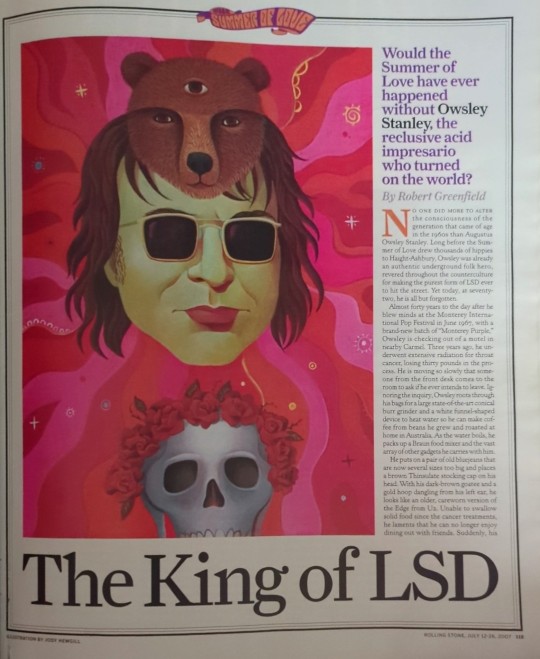
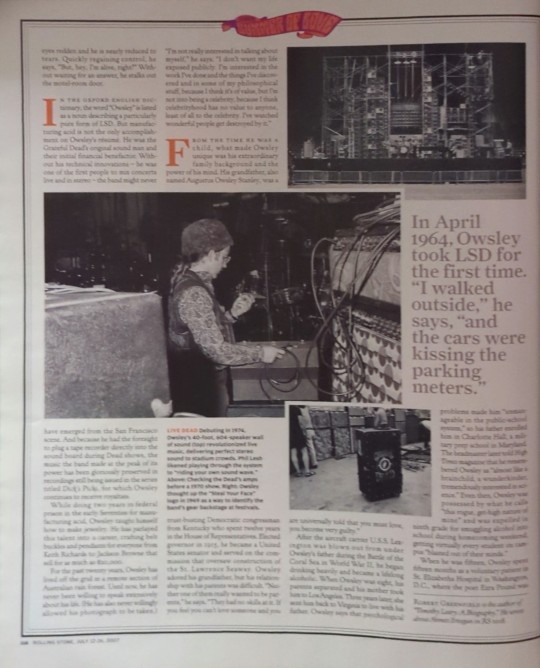
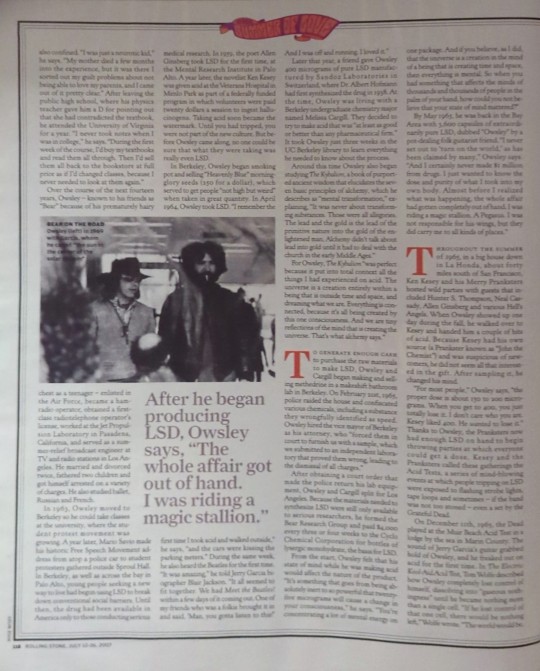
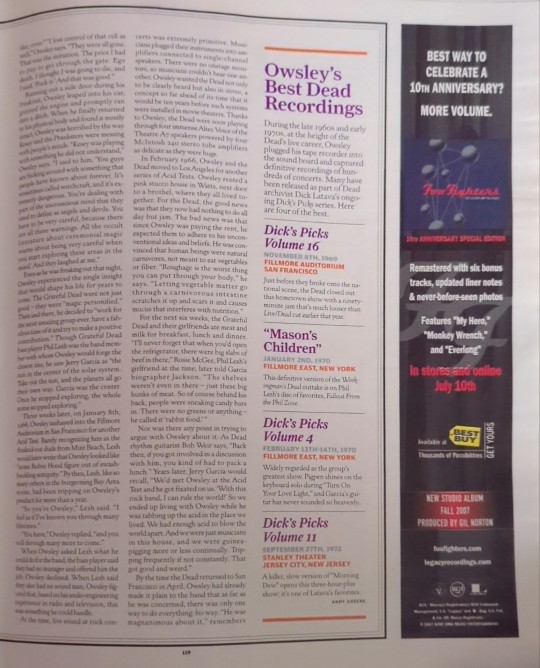
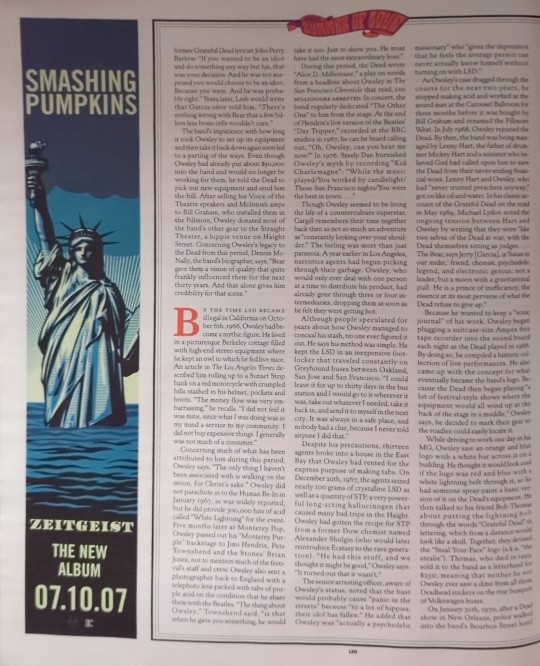

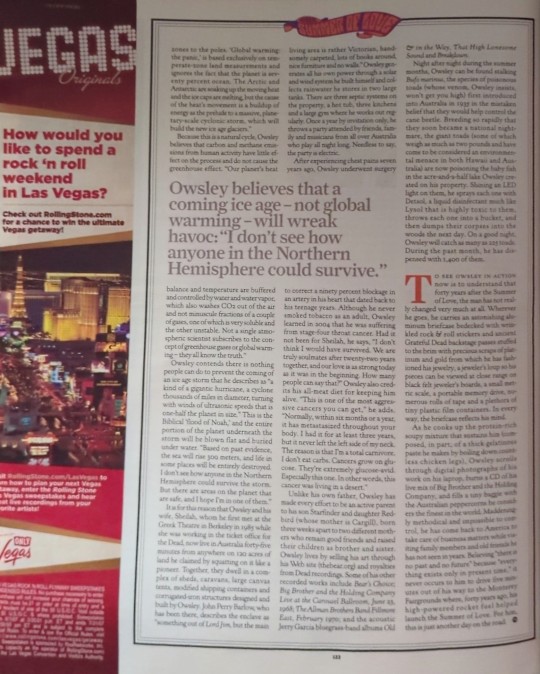
#rolling stone magazine#rolling stone#the fortieth anniversary#owsley stanley#lsd#jerry garcia#the grateful dead#ad#smashing pumpkins
0 notes
Text

Happy Birthday Tim Scully!!!
Robert "Tim" Scully born August 27, 1944
In heyday of LSD, secret Windsor lab produced millions of Orange Sunshine pills
Inside the Windsor Historical Society museum there are collections of fine art, archaeological artifacts, tools and household gadgets, thousands of items on shelves, in hutches and behind glass, some dating back nearly four centuries.
Two recently added items at the Hembree House - discretely placed posters in the two bathrooms - provide a hint, however, to a time in Windsor's past that is neither well known locally nor widely publicized.
In the late 1960s, a small group of hippie zealots worked feverishly in an old Windsor farmhouse to produce an especially pure form of LSD, on a mission to turn on the world.
Little was known about the clandestine lab because it was never busted. Authorities only found out about it several years after it was dismantled.
That hidden chapter of history had its start in late 1968 when the lab was set up in Windsor. Within a few months it produced roughly 3 pounds of LSD, or enough to make 4.5 million hits of “Orange Sunshine,” a nickname for the orange-colored, barrel-shaped pill that produced an especially powerful psychedelic trip.
It would become one of the iconic drugs of the late 1960s, proclaimed the finest acid in the land by Timothy Leary, the former Harvard instructor who famously advised people to “turn on, tune in, drop out.”
It was the year after the “Summer of Love” when thousands of flower children flocked to San Francisco to get high and groove in The Haight, espousing peace, love and Utopian ways. Some would come north to Sonoma County for back-to-the land communal living.
Among those who discovered Sonoma County was Tim Scully, a wonky East Bay kid and a physics major who'd dropped out of UC Berkeley. He and his associates chose Windsor to make LSD, which they saw as God's gift to humanity because of the ecstatic, consciousness-raising experience they had with the drug.
They chose a secluded Windsor farmhouse screened by trees, on 2 acres off Wilson Lane, now Mitchell Lane, to the west of Baldocchi Way. It was demolished more than 30 years ago to make way for Vintage Green subdivision homes.
“They invented Orange Sunshine, right here in Windsor,” said Windsor Historical Society President Steve Lehmann. “To me it's history. I'm surprised we don't have people doing some kind of pilgrimage here.”
“Sunshine Makers” come to Windsor
When Scully took LSD for the first time in April 1965 he felt at one with God and all living things.
Later that year he began hanging out with the San Francisco-based Grateful Dead, helping as sound engineer for the rock band along with Owsley “Bear” Stanley, already dubbed “The King of LSD” for the purity of his product.
The late Stanley, then 30, took the 21-year-old Scully as his apprentice beginning in mid-1966 at a lab in the basement of a rented house in Point Richmond. Stanley, his girlfriend and Scully cranked out 300,000 doses of “White Lightning” LSD. With the approaching 50th anniversary of the Summer of Love, the mayor of Richmond is trying to pinpoint the location and put up a commemorative plaque.
But in October 1966, LSD became illegal in California, and Stanley and Scully moved to Denver to set up a new lab.
The following year, Scully was introduced to Nick Sand, another underground chemist, and they collaborated in San Francisco to produce STP, a new psychedelic which was not yet illegal. Sand, another LSD proselytizer, had been introduced to LSD at Millbrook, an upstate New York farm and experimental community frequented by Leary.
By late 1967, Stanley was busted in connection with a tableting LSD lab in Orinda and Scully moved the Denver lab to another house.
But that was discovered in mid-1968 by authorities, when a water pump broke and police were called to the house while Scully was in Europe looking for precursor chemicals to make LSD.
Sand agreed to finance a new lab if Scully would teach him the Owsley Stanley manufacturing process.
Scully did on the condition that any LSD made be distributed through the Brotherhood of Eternal Love, rather than the Hells Angels. The former was described by some as a hippie mafia, a group of California surfers who evolved into a worldwide drug distribution network. The latter were notorious for gratuitous violence.
By late December, Sand through an intermediary, purchased the farmhouse in Windsor where he and Scully set up the large-scale LSD lab.
The real estate agent was told the buyer was a physics professor who wanted to set up a photography darkroom in the old farmhouse. The money came from proceeds of sales of psychedelics from Sand's STP lab.
Scully and his partner were in a hurry to make as much LSD as they could, because they believed the raw material would become unavailable. The drug is manufactured from lysergic acid, which is produced by the ergot fungus that grows on rye and other grains but can also be synthesized in a lab. The LSD made in Windsor came from one pound of lysergic acid that was made in Italy, but purchased in London.
Like an early version of “Breaking Bad,” a utility room of the Windsor house harbored a lab equipped with flasks, funnels and glass tubes, along with materials ranging from solvents to dry ice, nitrogen gas and - depending on what stage of the chemical process - ultraviolet or yellow bug lights.
There were vacuum pumps running to provide a steady puttering background sound. “The lab was next door to the kitchen where the glassware was scrupulously washed and cleaned,” Scully said.
“We would work until we dropped, sleep for a few hours and get up and at it again,” Sand recalled of the Windsor lab production in the 2015 documentary film “The Sunshine Makers.”
Turning on the world
Scully and Sand wanted people to have the same insight and intense experience of oneness and empathy they had while tripping. Scully “couldn't imagine how hatred, cruelty and destruction could continue to exist in the world, if everyone were to share this experience.”
“We agreed we couldn't just turn on the United States,” he said. “We had to turn on the whole world. Otherwise it would be like unilateral disarmament.”
Helped by the Brotherhood of Eternal Love, Orange Sunshine spread around the country, to Europe, India and even to American troops in Vietnam, and become part of the vernacular of the day.
While the crystalline LSD was made in Windsor, it was apportioned into tablets mostly in a house in Novato, using a triturate machine that stamped out several million doses.
Scully figured they needed to produce 440 pounds - about 720 million doses of LSD - roughly enough to provide a single dose for everyone in the world willing to try it.
But the law caught up with both men.
A recently minted pilot, Scully was arrested at the Napa Airport in May 1969 on charges stemming from the previous lab in Denver.
Sand, he said, immediately shut down the Windsor lab and remodeled and sanitized the room where it had been.
“Sand and Scully were apparently running this lab in Windsor and they did a good job of keeping it from us. We didn't find the lab,” retired narcotics officer Patrick Clark said in the 2015 documentary “The Sunshine Makers.”
But federal grand jury indictments and the testimony of Billy Hitchcock, the wealthy owner of Millbrook and a friend of theirs who had visited the Windsor lab, helped convict Scully, Sand and others.
In 1974, Scully was sentenced to 20 years in prison for LSD manufacturing and distribution, and Sand got 15 years. Both went to McNeil Island Federal Penitentiary in Washington state and were even cellmates.
Scully was released on an appeal bond partway through his prison term, and had his sentence cut in half, enabling him to be paroled after 3 ½ years.
He had earned his Ph.D. in psychology in prison and in 1979, was named Washington State Jaycees Outstanding Young Man of the Year. He was nominated based on his development of a computer device that enabled a person he knew with severe cerebral palsy to communicate using her knee movements that produced words on a TV screen.
While Scully said he knew by 1970 that he never wanted anything to do with manufacturing drugs, Sand was unrepentant.
While out on appeal, he bolted and spent the next 20 years evading authorities and living under various aliases. He spent time in India at Guru Rajneesh's ashram. When finally arrested in Canada in 1996, Sand had more than $500,000 in cash and gold and approximately 430,000 doses of LSD, according to newspaper accounts.
Sand went back to prison before being released in 2000. He died April 24 at his home in Lagunitas from apparent heart problems.
Busy in the woods
Scully, 72, now lives in Mendocino County in the backwoods community of Albion on a ridge near the Pacific Ocean. He said he long ago gave up any criminal activity.
Before his conviction and prison time, he founded his own electronics company and still repairs old instruments and computers in his one-bedroom house, cluttered with thousands of books, file cabinets, computer monitors and buckets of firewood for his wood stove.
His longtime partner, Alice Einhorn, lives on the 4-acre property, in a nearby house.
During a recent interview at his home, the gray-bearded Scully, wearing a slight smile, Panama hat, corduroy jeans and a blue hoodie sweatshirt, answered questions with the meticulous detail that hints at his slight Asperger's syndrome, a compulsive condition manifesting itself in inflexible routines, or pursuit of specific, narrow areas of interest.
In Scully's case, it was the way he ate the same type of spaghetti and butter dinner every night for decades, until health problems forced him to change.
For the past 20 years he's been gathering the history of underground LSD manufacturing and has a large database linking chronologies, court records and PDFs of people, labs and locations. He says it will be useful for historians and university libraries. He is also working on a memoir.
After LSD, Scully became interested in making brain wave biofeedback instruments. In a two-page spread in 1970, Life magazine referenced his company, Aquarius Electronics, in an articled entitled “turning on with Alpha waves.”
When it was apparent his drug record would prevent him from teaching, he started working as a consultant to a software computer corporation, joining a techie world where LSD use is not necessarily seen as an automatic disqualifier. Late Apple CEO Steve Jobs, for example, admitted using it.
Scully was hired as a full-time software developer for Marin-based Autodesk Inc. before retiring a dozen years ago and now relies on income from some long-term tenants on his property.
Looking back, Scully has a more balanced view than he once did of both the good and the bad that LSD unleashed.
For some it offered an intensely spiritual experience and especially influenced music and art. But it also induces paranoia, and can trigger, or worsen underlying psychiatric disorders. At its height of popularity in the late 1960s and early 1970s, thousands of freaked-out kids on “bad trips” were picked up annually by police.
“The majority of the people who took LSD had pretty good experiences,” Scully said. “Certainly a few had serious trouble and quite a few ended up in emergency rooms, because they were frightened. Most were fine the next day, but some had long-term issues.”
Although LSD carried a message of peace and love for him and many others, Scully came to realize over the years that it was “more of an amplifier than a message carrier.” Looking back, he says it was a mistake to make it widely available, “to scatter it to the four winds, so young people who were too young to have fully formed personalities were getting it.
“I have some regret,” he said. “We didn't succeed in saving the world, obviously. Look at who's in the White House now.”
But there is that quirky historic link to Windsor, a town that went from a dusty farm crossroads dubbed “Poor Man's Flat” to a family-friendly bedroom community.
The History Society's Lehmann first found about the LSD connection reading a passing reference on page 266 of an obscure book entitled “Hippie.”
He said the museum has to tread a fine line to avoid sounding like it's promoting a drug, especially considering that fourth-graders visit the museum on school trips.
Lehmann finds the characters involved with the Windsor lab fascinating, “but not everyone smiles when you talk about LSD.”
Still, he noted, the museum doesn't shy away from talking about the area's illegal booze production during Prohibition.
“We're joking about putting up a plaque at the park, across the street from where the farmhouse was,” he said. “I'm wondering if Windsor is ready for such a plaque.”
Editor's note: The article has been updated with the correct name of Owsley “Bear” Stanley and to reflect that Scully studied physics at UC Berkeley but did not obtain a degree there. The location of the LSD lab inside the Windsor home as well as the tableting process in Novato has also been clarified.
#PsychedelicSynchronicity
#buy lsd online#lsdtrip#lsdblotter#lsd dream emulator#lsd#Tim skully#pgoeltz#bitterrootvalley#montana#youtube#scvwd#music#gratefuldead#catflinger#flowers#valleywater scvwd#owsley stanley#bears
1 note
·
View note
Text

#grateful dead#dancing bear#dancing bears#owsley Stanley#deadheads#deadhead#dead and company#dead and co
1 note
·
View note
Photo

Owsley Stanley Foundation archives
via Johnny Cash's San Francisco Show From 1968 to Be Released)
30 notes
·
View notes
Text


"Stanley's War", Power Man and Iron Fist #115, March 1985, written by Jim Owsley, original art by Mark Bright (pencils) and Jerry Acerno (inks)
6 notes
·
View notes
Photo
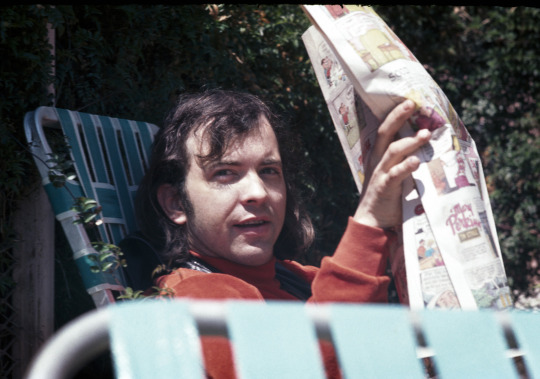
Kid Charlemagne, 1967
Photo by Ron Rakow
17 notes
·
View notes
Text

“Mini-Woodstock” Set for Release
- Bear’s Sonic Journals: Sing Out!, featuring Grateful Dead members, Country Joe McDonald and others, due Feb. 23
Owsley “Bear” Stanley’s final known recording of Grateful Dead members will be released Feb. 23 as Bear’s Sonic Journals: Sing Out!
“It started out as a small, acoustical concert and turned into a mini-Woodstock,” Wavy Gravy said of the April 25, 1981, gig the Berkeley Community Theater.
The three-disc, 36-song collection features sets by two-thirds of the Grateful Dead, the Rhythm Devils, Country Joe McDonald, Kate Wolf and Rosalie Sorrels. It was announced with a 90-second recording of Jerry Garcia, Bob Weir, the Devils (aka the Dead’s Bill Kreutzmann and Mickey Hart) and Jerry Garcia Band bassist John Kahn playing the slow arrangement of “Friend of the Devil” on acoustic instruments.
The release represents the 10th edition of Bear’s Sonic Journals and includes a 50-page booklet with previously unpublished photos from the concerts alongside essays and other artwork.
Hear the “Friend of the Devil” teaser here.
1/22/24
#bear’s sonic journals#owsley stanley#grateful dead#the rhythm devils#jerry garcia#bob weir#bill kreutzmann#mickey hart#john kahn#jerry garcia band#country joe mcdonald#kate wolf#rosalie sorrels#wavy gravy
1 note
·
View note
Text
5 notes
·
View notes
Text
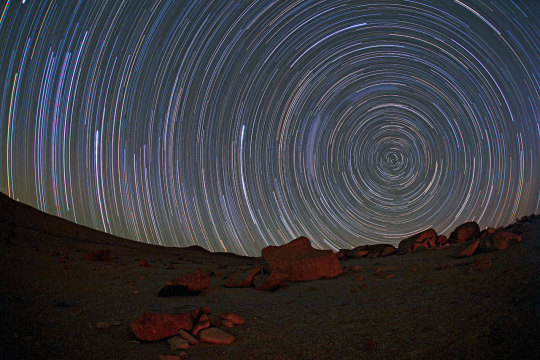
“The universe is a creation entirely within a being that is outside time and space, and dreaming what we are. Everything is connected, because it’s all being created by this one consciousness. And we are tiny reflections of the mind that is creating the universe.” - Owsley Stanley.
32 notes
·
View notes